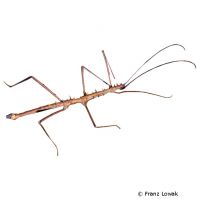Stick Bug (Acanthomenexenus polyacanthus)
| Stick Bug Acanthomenexenus polyacanthus | |
|---|---|
| Name | Stick Bug |
| Name Lat. | Acanthomenexenus polyacanthus |
| Family | Lonchodid Stick Insects |
| Family lat. | Lonchodidae |
| Order | Phasmids |
| Order lat. | Phasmatodea |
| Origin | Indonesia |
| Habitat | Tropical forest |
| Diet | Fresh rose-family leaves |
| Humidity | 60-80 % |
| Behavior | Peaceful |
| Keeping | Individual, pair, group |
| Care Level | Easy |
| Housing | Semi-humid terrarium |
| Breeding | Simple |
| Life Span | 6-12 months |
| Protection | No |
| Metric Units | |
| Size | 4-6 cm |
| Temperature Day | 20-24 °C |
| Temperature Night | 18-22 °C |
| Housing Size | 30 x 30 x 40 cm |
| US Units | |
| Size | 1.6"-2.4" |
| Temperature Day | 68-75 °F |
| Temperature Night | 64-72 °F |
| Housing Size | 10" x 10" x 15" |
Distribution and habitat
The crepuscular and nocturnal longhorned grasshoppers originate from Sangihe Island (Indonesia), a small island between Sulawesi and Mindanao (Philippines). There they live on bushes and shrubs of the tropical rainforests.
Maintenance
A terrarium of L 30 x W 30 x H 40 cm for a pair is recommended. A terrarium with a cover made of gauze or fine metal mesh is best. The terrarium should be placed in a quiet place without sunlight
They need climbing facilities, such as cork back walls as well as twigs and branches, which also serve as food plants and a narrow-necked, stable water container (e.g. vase) for the food plants. Suitable substrate is terrarium humus or a soil-sand mixture covered with moss, which should always be kept slightly moist. The terrarium should be finely sprayed with water (humidity) once a day, preferably in the evening inside, but a rain or mist system is better. Waterlogging should be avoided at all costs
| Daytime temperature: 20-24 °C | Temp. night: 18-22 °C | Humidity: 60-80 |
Although the animals are nocturnal, a light source that also produces the necessary heat is ideal. The lighting duration should be 8-12 hours, depending on the season
Diet
The food supply consists of fresh leaves of blackberry, honeysuckle (Lonicera nitida) and ivy (Hedera helix), as well as leaves of ferns. Leaves of other roses and rose plants, such as red and hawthorn, raspberry, currant, wild rose, etc., as well as the leaves of beech, oak, linden, hazel or sweet chestnut are also accepted in different individual ways. Blackberries are ideal as food in winter, as they remain green. By spraying the forage plants, the animals can satisfy their drinking needs. In addition, a wick waterer is recommended. Eaten branches must be replaced regularly
A regular and varied diet promotes the well-being of the animals.
Reproduction and breeding
The males are slightly smaller, more slender and the unwinged body has a bluish coloration. The larger females are also unwinged and their body is brownish with a yellow-beige stripe running across the head, thorax and abdomen
They can reproduce sexually or asexually by virgin reproduction (parthenogenesis). This produces offspring from unfertilized eggs. The hatching rate is greater in sexual reproduction. One female can lay over 100 eggs, which are simply dropped on the ground. The incubation period is 3-4 months at 20-23 °C. The newly hatched green young are very similar to ants (ant mimicry). In general, the number of male offspring is lower. After the last molt (imaginal molt) females live up to 12, males up to 6 months
Important
For molting, they hang upside down in the branches or on the lattice cover and slide out of their old shell. Therefore, they need at least one body length of free space below them.
With their camouflage costume they adapt to their environment and can thus be detected by their predators only with difficulty (mimesis).
Before purchasing, a terrarium should be prepared that meets the species-specific needs. Good ventilation without drafts is necessary, as well as equipment for measuring temperature and humidity. The lighting has to correspond to the species-specific day-night rhythm and has to be installed in such a way that the animals cannot injure themselves
The terrarium should be locked in such a way that neither unauthorized persons can open it nor the animals can escape. Special attention must be paid to thorough hygiene and impurities must be removed regularly
Further literature can be found in your pet store
References
Text: Eveline Strizsik; Image: Franz Lowak
Source: SEILER, BRADLER, KOCH (2000): Ratgeber Phasmiden, Verlag Bede; ENGELMANN & LANGE (2011): Zootierhaltung - Tiere in menschlicher Obhut: Wirbellose, Harri Deutsch Verlag
